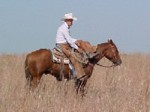
|
Welcome to Texas Ranching Conservancy's Rangeland Ranching Website |
| |
|
|
|
|
Historically, Texas and other range states have been characterized around the world as a land of large working ranches, wide-open spaces, large expanses of rangeland, oceans of grass, cowboys and horses, large herds of cattle, tasty rangefed beef, and abundance of wildlife. Yet the truth is that since the late 1800's and early 1900's, the earliest days of our country's range cattle industry, the type of ranches that made Texas and other range states famous have been shrinking in size, number, and productivity. The primary reason for the losses is because, over the years, financial returns from rangeland ranching have been very low, and ranchers seldom have a financial incentive to maintain their rangeland in good to excellent range condition. As a result, ranchers frequently
Unfortunately, due to a history of ranchers degrading and fragmenting their rangeland in an attempt to improve their financial position, a high percent of the old-time working ranches in Texas and other range states and regions have been degraded and fragmented to the point where they no longer have enough animal unit carrying capacity to be financially viable on an one-operation (independent) basis. In fact, a high percent of our state's, our country's old-time working ranches -- which includes desert, prairie, savanna, and forest types -- have been degraded and fragmented to the point where operating them as grazing operations is a total waste of time and money, and any attempt to do so must be avoided. Because of a growing demand for ranchettes, hunting reserves, country housing, public recreation, and other types of human activities and development endeavors, many of today's ranch owners are choosing to improve their financial position by simply selling their ranches to speculators and developers, and doing so one piece of rangeland at a time. Because of today's trends in population growth and urban sprawl, most ranch owners choosing this financial alternative can find plenty of buyers for about any amount and quality of rangeland they want to sell. For example, during the 1990s, more than quarter-million acres of Texas rangeland was lost each year to subdividing, and the number and size of our state's old-time working ranches declined tremendously. NOW, before our state's, our country's remaining mid- and large-size working ranches become chopped-up into little pieces and lost forever, efforts must be made to preserve as much of what's left as possible for the benefit of future generations. Doing this is critical because after all of our state's, our country's old-time working ranches are gone, the cultural lifestyle and wildlife they support, the agricultural goods they produce, as well as the ecological services their grazing land provide will be gone too. Because of today's growing demand for small tracks of rangeland (which is expected to nearly double in Texas by 2050), we feel that having any chance to prevent further loss of mid- and large-size working ranches, and therefore prevent further loss of our state's, our country's old-time ranching heritage, culture, and pastoral way of life, will require like-minded people joining together as a group for the purpose of setting forth and supporting a plan for accomplishing such an objective. We believe that immediate action on this requirement is necessary! |
|
|
Website contents |
|
|
If you have any questions or comments on any of the information presented at this website, or if you are interested in becoming an ally or just a friend of our group, please don't hesitate dropping us a message in our mailbox. We appreciate hearing from anyone interested in subject matter relating to rangeland ranching and native rangelands. |
|
|
Copyright © 2021 Texas Ranching Conservancy |
|
|
|
|
|
http://www.texasranchingconservancy.com/index.html Last Site Update: December, 2021 |
|
